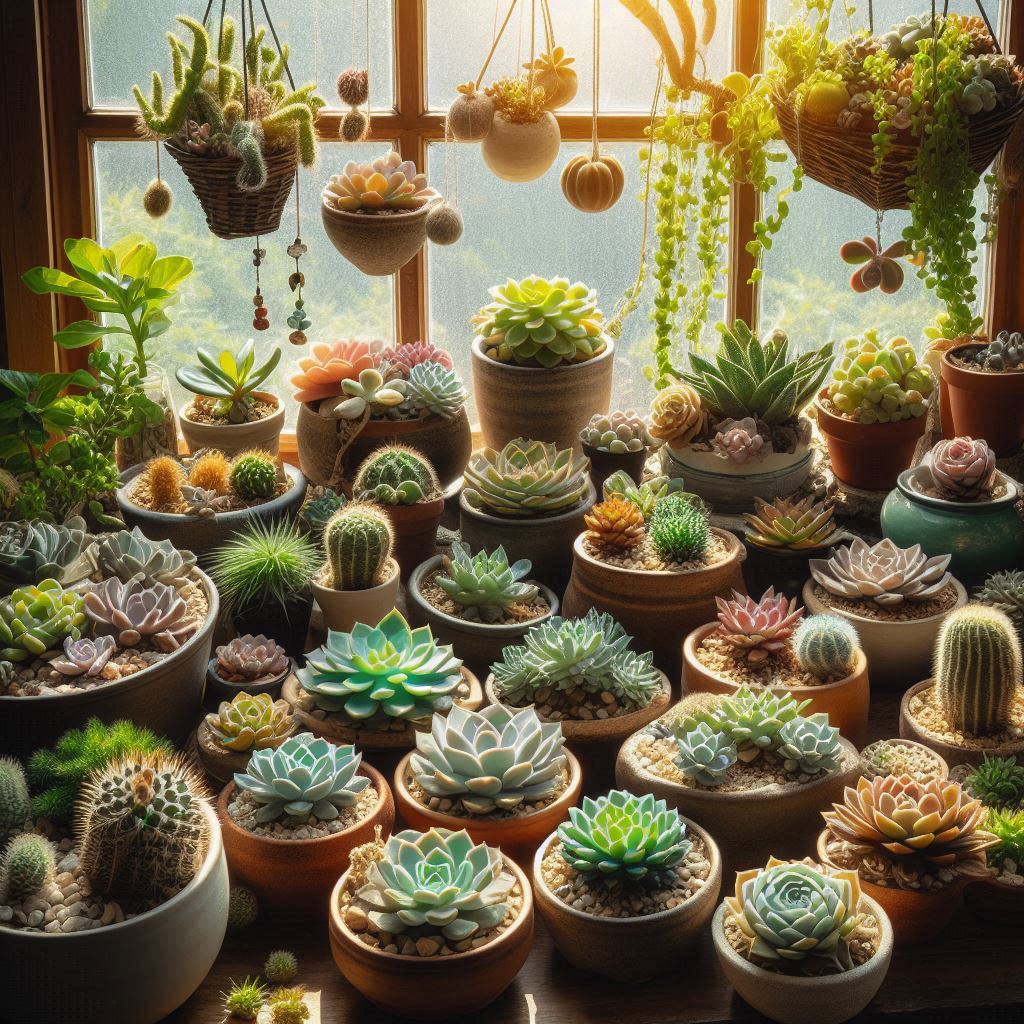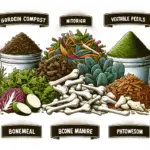How long can a succulent go without water? Are you wondering how long your beloved succulent can survive without water? Succulents are well-known for their ability to withstand dry conditions, thanks to their incredible water retention capabilities. In this guide, we’ll explore everything you need to know about succulent hydration, from understanding their specific needs to crafting an effective care schedule. Whether you’re a seasoned plant enthusiast or a curious beginner, these insights will help you ensure your succulents thrive.
Understanding a Succulent’s Water Storage Capabilities
Succulents are unique plants with remarkable water storage abilities that allow them to survive in arid environments for extended periods. These plants possess specialized tissues that hold water in their leaves, stems, and even roots. This ability stems from their native habitats where rainfall is unpredictable, and water conservation is crucial.
The water-storing tissues not only help succulents endure drought conditions but also store nourishment during lean times. Succulents’ adaptations enable them to thrive with minimal water, making them ideal for indoor gardening and climates where water might be scarce. Their waxy skin reduces evaporation, and their ability to close stomata during the daytime maximizes water use efficiency.
Additionally, succulents can swell noticeably after watering, a testament to their powerful water absorption capabilities. This characteristic not only helps them survive but also provides an aesthetic element to the plants, as their healthy state reflects vibrant colors and firm leaves.
These features mean that while certainly resilient, succulents are not immune to water deprivation and do express signs of needing water, such as shriveling leaves or losing firmness. Understanding these water storage and retention traits gives us insights into best practices for maintaining them over long dry spells, ensuring they remain a robust and lush presence in any plant collection.
How Long Different Succulent Varieties Can Go Without Water
Many succulent varieties have different abilities to withstand dry periods thanks to their unique water-storing properties. Echeveria, for instance, can typically go about two weeks without water, while Sedum varieties might survive closer to three weeks. However, the sturdy Aloe Vera can endure for at least a month without a drop. It’s essential to consider each species’ native habitat when predicting their drought tolerance.
Factors like temperature and humidity also play roles. Warmer climates may dehydrate succulents faster, while cooler, more humid environments might allow longer gaps between watering sessions. Each variety’s adaptation stems from their origin, like desert-dwelling succulents thriving with sparse water, contrasted with subtropical species that might need more frequent fluids.
Tips for Managing Varieties
Check the leaves for signs of dehydration—wilted or shriveled leaves often indicate a need for water. Always remember, a little research about your specific succulent type will go a long way in keeping them healthy. Adjust your watering schedule according to the variety’s resilience and environmental conditions to avoid under or overwatering.
What Happens to Succulents During Extended Periods Without Water
During dry spells, succulents enter a survival mode. These resilient plants have evolved unique methods to endure extended periods without water. Their fleshy leaves serve as reservoirs, storing moisture to be used when needed. However, when deprived of water for too long, their robust nature is tested.
Stress Responses: When succulents go without water for an extended time, they prioritize survival. They reduce growth and focus energy on conserving water. The outer leaves might start to shrivel or turn slightly brown, which is a natural defense mechanism.
Photosynthesis Adjustments: Succulents may modify their photosynthesis process. Some will close their stomata during the day to prevent water loss and open them at night to minimize evaporation, utilizing CAM photosynthesis.
Long-term Drought Outcomes: A succulent’s growth will slow dramatically after weeks of no water. With continued drought, the leaves become more wrinkled, and the plant might shed leaves to reduce water demands.
Recovery Potential: Despite signs of stress, many succulents can bounce back once rehydrated. However, prolonged dryness can lead to irreversible damage, particularly in juvenile or sensitive species.
Monitoring your succulent’s condition during these periods can help determine when minimal intervention is necessary to keep them thriving.
Signs That a Succulent Needs Water After a Dry Spell
During a dry spell, succulents exhibit specific signs indicating they require hydration. One of the most prominent signs is shriveling leaves. If the leaves appear wrinkled or puckered, it’s a clear indication that the succulent is thirsty.
Another noticeable sign is a change in leaf color. When succulents need water, their leaves might take on a dull or matte appearance, deviating from their usual vibrant hues. This transformation is because the plant is extracting water from its storage to survive.
Softened leaves are another indicator. When a succulent’s leaves become soft to the touch, it’s often a sign that the water reserves are depleting. Healthy succulent leaves should feel firm, not squishy.
Moreover, observe the plant for signs of stem sagging. In severe cases of dehydration, succulents might noticeably droop or lean as the stems become weaker without adequate water support.
Finally, some succulents may start shedding lower leaves as a survival tactic to reduce surface area and conserve moisture. Keep an eye on the base of your plant for any fallen leaves.
How Climate Affects a Succulent’s Ability to Go Without Water
The ability of succulents to withstand prolonged periods without water is greatly influenced by the surrounding climate. In cooler and more humid environments, succulents can thrive with minimal water as the evaporation rate is lower and moisture retention is higher. However, in hotter and arid climates, succulents may require more frequent watering due to rapid evaporation and soil drying.
Succulents have developed unique adaptations to survive in various climates. For instance, in desert regions, they have thick, fleshy leaves that store water effectively, minimizing their need for frequent watering. On the other hand, in cooler climates, succulents might have thinner leaves because the need for heavy water storage is reduced.
Climate also affects the dormancy periods of succulents. During cooler months, these plants generally need less water, while in the growing season, typically characterized by warmer weather, their water requirements increase. Understanding these climate-related needs is crucial for succulent care, ensuring that they remain healthy and vibrant regardless of the geographical location.
The positioning of succulents in relation to direct sunlight is another climatic factor impacting their water needs. Succulents exposed to more sunlight will lose moisture faster compared to those in shaded areas. Hence, knowing the specific climatic conditions of your region will help determine the optimal watering schedule for your succulents, preserving their robustness and natural beauty.
Indoor vs. Outdoor Succulents: Watering Needs and Durations

When it comes to succulents, understanding the differences between indoor and outdoor watering requirements is crucial for maintaining their health. Indoor succulents typically require less frequent watering compared to their outdoor counterparts. This is because the indoor environment exposes them to less sunlight and heat, leading to slower evaporation rates. Thus, watering indoor succulents every two to three weeks may suffice.
On the other hand, outdoor succulents are subjected to varying environmental conditions, including increased sun exposure and possibly greater air flow, which boost their water usage. Depending on the climate, these rugged plants might need more frequent watering, sometimes once a week during hot and dry periods.
The drainage capability of the soil plays a significant role in determining how frequently these plants need water. Quick-draining soil is beneficial in both settings but especially important for outdoor succulents, as it helps prevent root rot by allowing excess moisture to escape easily.
Moreover, variations in local climate can further impact how you water your succulents. Colder, more humid environments might reduce the need for additional water, while hot, arid climates increase water demand.
It’s important to optimize your watering strategy based on whether your succulents are kept indoors or outdoors, ensuring they receive just the right amount of hydration to thrive.
How Soil Type Influences a Succulent’s Water Retention
The type of soil you choose for your succulents plays a crucial role in how well they retain water. Succulents are known for their ability to store water within their leaves, but the soil must also support this characteristic. Well-draining soil is essential to prevent root rot and to mimic the plant’s natural habitat.
Sand or sandy loam is often recommended because it doesn’t hold onto water for long, ensuring that the succulent’s roots do not stay overly wet. This is crucial as excess water can lead to rot, a common problem for succulents. Additives like perlite or pumice can improve drainage and aeration, assisting in the water retention balance.
On the other hand, clay or compacted soils can retain too much moisture, leading to challenges in succulent health. Moisture levels in these soils can smother the roots if not managed properly. Therefore, understanding the characteristics of your potting mix can significantly affect how long a succulent can go without being watered.
In an indoor setting, the choice of soil becomes even more pivotal since indoor environments may not have natural evapotranspiration processes. Thus, modifying your indoor soil mix to include faster-draining components can help maintain an optimal moisture level, reducing the risk of overwatering.
Ultimately, knowing how the soil type influences water retention can empower gardeners to make better choices, ensuring that succulents stay healthy even during extended dry spells. This not only secures the plant’s longevity but also enhances its overall appearance.
How Long Succulents Can Survive Drought Conditions
Succulents are known for their incredible resilience to drought conditions, which is largely due to their unique water storage capabilities. These plants have evolved to withstand prolonged periods without water and can adapt to various climates. On average, most succulent species can survive several weeks to months without water. However, the duration varies greatly depending on several factors.
Understanding a Succulent’s Water Storage Capabilities: Succulents store water in their leaves, stems, or roots, allowing them to endure dry spells. Their ability to retain water is key to surviving long periods without moisture. The water storage mechanism acts as a reservoir, enabling them to thrive in arid conditions.
Another crucial factor is the specific variety of succulent. For instance, cacti, a subset of succulents, are notorious for their drought resistance and can last for months without water. Conversely, some tropical succulents might need more frequent watering, but even they can manage several weeks in dry conditions.
During extended droughts, succulents undergo physiological changes to conserve water. They close their leaf pores to minimize water loss and may even sacrifice older leaves to retain moisture for younger ones. However, this adaptation has limits, and if deprived for too long, succulents will start to show indicators of distress.
Visible signs such as shriveled leaves and slowed growth are good indicators that a succulent needs water. Preventive measures like adjusting light exposure and using well-draining soil can enhance their drought survival rate.
Climate plays a significant role in a succulent’s ability to endure drought. In humid areas, succulents may require less water due to ambient moisture, whereas in dry, hot climates, they might need more attention. Additionally, whether a succulent is grown indoors versus outdoors significantly impacts its watering schedule. Indoor plants typically receive less direct sunlight and may retain moisture longer than their outdoor counterparts.
Lastly, the type of soil is crucial for water retention. Well-draining, gritty soil is conducive to maintaining enough moisture for succulents without risking waterlogging, which can cause root rot.
Tips for Keeping Succulents Hydrated During Long Dry Periods
Keeping your succulents adequately hydrated during extended dry periods is crucial to ensure their survival and health. Succulents are masters at storing water in their leaves and stems, yet during prolonged droughts, they still need some help. Water deeply but infrequently to mimic their natural habitat. This allows them to soak up the water and store it for future use.
Use soil that drains quickly to prevent root rot, as succulents are susceptible to having too much water near their roots. Placing rocks or gravel at the bottom of pots can also help with drainage. Additionally, ensure your succulents have access to indirect sunlight, as direct sunlight can dehydrate them further.
Incorporate a layer of mulch on top of the soil, as this can help maintain moisture levels around the plant. During excessively dry periods, you can consider creating a makeshift humidity tray by filling a shallow dish with water and placing it near your succulents. This will add some moisture to the air, assisting in keeping them hydrated without overwatering the soil.
Remember that different succulent species have distinct hydration needs. Always check specific requirements for the type of succulent you have. Watching for signs of stress like shriveled or crispy leaves can alert you when it’s time to water.
How Dormancy Affects a Succulent’s Watering Schedule
During their dormancy period, succulents require significantly less water. This phase often takes place during the plant’s natural resting cycle, which can occur in summer or winter depending on the variety. While many plants slow their growth during dormancy, succulents utilize this time to conserve energy and moisture.
Understanding how dormancy impacts their watering schedule is crucial. When a succulent enters dormancy, its water needs decrease drastically. Overwatering during this time can lead to root rot, a common issue for succulents. Therefore, it’s advisable to adjust your watering habits accordingly.
Most succulents can thrive with minimal water during dormancy. For instance, rather than following a strict schedule, it’s better to allow the soil to dry out completely before watering again. Monitoring the plant’s leaves is also essential, as they often show signs of thirst by becoming wrinkled or soft.
Additionally, external factors, such as light and temperature, play a role in a succulent’s dormancy. In environments with cooler temperatures and less sunlight, succulents might require even less water, emphasizing the importance of recognizing individual needs.
In summary, adjusting your watering routine to accommodate dormancy can help maintain a healthy and resilient succulent. By understanding these changes, you can ensure your plant thrives all year round.
Common Misconceptions About Succulents and Watering Frequency
Many individuals believe that succulents require constant watering, similar to other houseplants, which is a common misconception. Succulents are built to endure periods of drought, thanks to their specialized water storage tissues. However, the watering frequency doesn’t follow a one-size-fits-all rule and depends significantly on the specific succulent variety and environmental factors. Another myth is that succulents don’t need water at all, which can lead to neglect and eventually harm the plant.
Understanding the balance required in watering is crucial. Some assume that succulents can be treated the same as cacti regarding watering frequency, yet succulents may need a slightly more consistent watering schedule. Overwatering is another pitfall many succulent owners fall into, mistaken in thinking that the plants need as much moisture as others.
Additionally, many believe that a succulent’s wilted appearance indicates a need for water, but this could also suggest overwatering, root rot, or other challenges. Educating oneself about each succulent’s unique needs helps in avoiding these misconceptions and promotes healthier plant growth.
Best Practices for Watering Succulents After a Long Dry Period
After an extended period without hydration, succulents require careful reintroduction to water. Understanding the best practices helps avoid complications such as root rot or leaf damage. When watering succulents after a dry spell, remember to be gradual. Start with a small amount of water to allow the plant to adjust, avoiding a sudden influx that might shock the roots.
Allow the water to fully absorb into the soil before offering more. This method gives the roots a chance to revive without becoming overwhelmed. Ensure the soil is well-draining, as this prevents water from sitting around the roots. Observe your succulent closely after watering, looking for signs of improvement, such as firmer leaves and a healthier overall appearance.
It’s best to water during the early morning or late afternoon, when temperatures are cooler, reducing evaporation. Avoid watering in direct sunlight as this can cause damage to the foliage. Regularly check the soil moisture; it should be allowed to dry out completely between each watering session. This practice is essential for maintaining plant health and supporting its natural water-storing capabilities.
Succulents are remarkable plants known for their water storage capabilities. Many people recognize their ability to thrive in arid conditions due to thick leaves and stems. These structures are specialized to store water, allowing succulents to endure periods without watering. This adaptation helps them survive in their native environments and makes them low-maintenance plants for collectors.
Varieties and Water Needs differ significantly, as some types can endure weeks or even months without additional water. While succulents like jade plants might not need frequent watering, others, such as aloe vera, might require a bit more attention, especially in warmer climates.
During extended dry spells, succulents shift to survival mode, consuming stored water slowly. This adaptation helps them conserve moisture. As dehydration progresses, they might shed leaves to reduce water loss, focusing on core survival.
Signs of Water Necessity can include shriveled or soft leaves, indicating depletion of water reserves. It’s crucial to observe these signals to prevent stress on the plant.
Outdoor succulents may face longer dry periods than indoor ones, relying on natural rainfall, which can be unpredictable. Indoor environments provide more controlled conditions, yet succulents may still rely heavily on regular soakings adjusted for seasonal changes.
Soil Composition also plays a significant role in how long succulents can last without additional watering. Soils that drain well can maintain moisture levels appropriately, whereas dense, poorly draining soil might cause root rot if overwatered.
Understanding these unique plant needs ensures they remain hydrated, healthy, and thriving, regardless of the outdoor conditions they face. Proper techniques, like adjusting watering methods post-drought, confirm their continued growth and prevent common misconceptions about their watering frequency needs.







